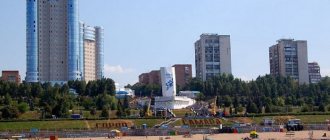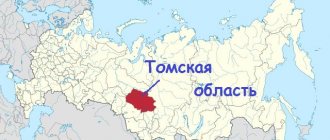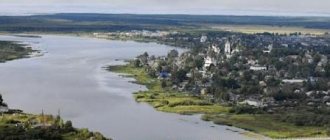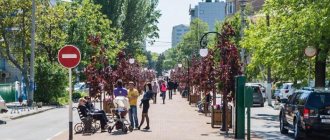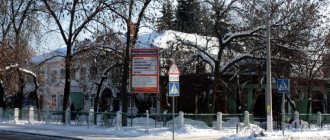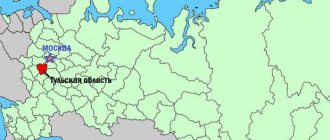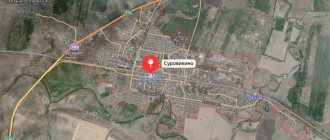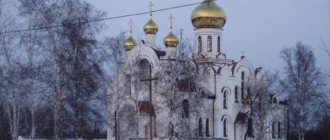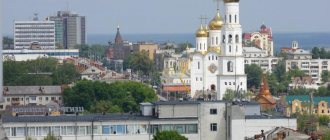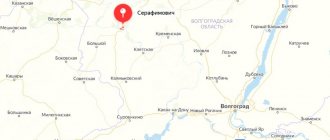On the border with the countries of the former Soviet Union, Belarus and Ukraine, is the city of Bryansk, whose population is very proud of its place of residence. And not without reason, because this settlement has a centuries-old and very fascinating history. In addition, the city often appears in fairy tales about Nightingale the Robber, a monument to which local authorities have been planning to erect for a very long time. This glorious and cozy city is mentioned in many chronicles, but only a few know its history, and especially the history of its inhabitants. This and much more will be discussed in the article.
History of the emergence and development of the city
The first data about the city dates back to the first millennium. Archaeologists have even found traces of the very first settlement. In addition, in many chronicles, Bryansk acts as a kind of “green shield” for its residents. For example, during the Tatar-Mongol invasion, the city’s residents were not harmed precisely because the enemies were frightened by the impenetrability of the forests surrounding the settlement.
The first ruler of the city was Prince Roman, the son of the appanage Prince Mikhail. Under the rule of this man, Bryansk became significantly richer, because Roman Bryansky had a good grasp of trade affairs. Moreover, the purchase and sale was carried out precisely with the West, where they exported honey, wax, fur, and received silk, soap and a wide variety of jewelry from there. The favorable location allowed Bryansk to feel confident in trade.
Peter I also visited this city. Thanks to his decree, the shipbuilding industry was launched. Many places in the city were noted by Peter I, and various legends on this topic are still passed down to subsequent generations.
Since the eighteenth century, industry began to flourish in this city, various plants and factories were built, and a wide variety of objects and things were produced. Today, much has been preserved from those times, but even more buildings and industrial facilities have been rebuilt or restored.
Employment
What level of unemployment and employment can Bryansk demonstrate? The city's population complains about the lack of enterprises with decent wages. Finding a job in Bryansk is not so difficult, but providing for your family is an almost impossible task. That is why many local residents are not limited to one source of income and earn extra money in their free time. If we talk about prices for goods and services, they differ little from those in the capital. An exception, perhaps, is the cost of transport and meat products.
The largest city-forming enterprise in Bryansk is a machine-building plant specializing in energy and transport engineering. The enterprise provides 7,000 jobs, and it is here that young specialists are sent after graduating from the Bryansk Technical Institute.
Arsenal is another large enterprise in the city, specializing in the production of special equipment, primarily asphalt pavers. This is a modern enterprise that keeps up with the times. Production volumes increase every year, workers receive stable wages, not bad for the city and region. The company cares about the safety and health of its employees, annually sending the best specialists to sanatorium and resort treatment. Children of employees relax in the best health camps in the region.
Local authorities need to focus their main efforts on increasing the birth rate in the region, combating mortality, and also providing city residents with jobs with decent wages. Otherwise, in the near future, only old people will live here.
Unusual data on the history of the city
The name of Bryansk used to be somewhat different. It contained the prefix “de” - D’bryansk. Many people believe that this name implied the location of the city among impassable forests. In reality, everything is somewhat different. Today it is known that in Old Slavonic sources the word “Dybr” meant “mountain slope, gorge.”
The following fact is also interesting: between the celebration of the 838th anniversary of the city’s founding and its thousandth birthday, only one calendar year passed. This curious feature and an amazing coincidence of circumstances are explained by the results of excavations, during which archaeologists were able to establish the real age of the city.
During the Great Patriotic War, Bryansk was simply a center of partisan brigades. About forty thousand people took part in this dangerous task.
Map
| Bryansk: maps |
Bryansk: photo from space (Google Maps) Bryansk: photo from space (Microsoft Virtual Earth)
| Bryansk. Nearest cities. Distances in km. on the map (in brackets along roads) + direction. Using the hyperlink in the distance , you can get the route (information courtesy of the AutoTransInfo website) | |||
| 1 | Suponevo | 6 () | SW |
| 2 | Bolshoye Polpino | 8 () | IN |
| 3 | Glinishchevo | 19 () | Z |
| 4 | White Shores | 20 (28) | IN |
| 5 | Seltso | 21 (36) | NW |
| 6 | Fokino | 22 (31) | WITH |
| 7 | Vygonichi | 26 (25) | SW |
| 8 | Lyubohna | 28 (35) | WITH |
| 9 | Rzhanitsa | 36 (84) | NW |
| 10 | Dyatkovo | 38 (45) | WITH |
| 11 | Zhiryatino | 42 (52) | Z |
| 12 | Karachev | 43 (47) | IN |
| 13 | And so | 48 (57) | WITH |
| 14 | Navlya | 48 (63) | YU |
| 15 | Zhukovka | 52 (65) | NW |
| 16 | Khvastovichi (Kaluga region) | 54 (83) | NE |
| 17 | Zhizdra | 60 (90) | NE |
| 18 | Lyudinovo | 68 (79) | WITH |
| 19 | Pochep | 70 (79) | SW |
| 20 | Khotynets (Oryol region) | 70 (86) | IN |
| 21 | Shablykino (Oryol region) | 71 (110) | SE |
| 22 | Dubrovka | 75 (86) | NW |
| 23 | Kletnya | 77 (94) | Z |
| 24 | Elbow | 77 (95) | YU |
| 25 | Rognedino | 81 (100) | NW |
| 26 | Trubchevsk | 84 (89) | SW |
| 27 | Znamenskoye (Oryol region) | 87 (116) | IN |
| 28 | Soskovo (Oryol region) | 87 (139) | SE |
| 29 | Betlitsa (Kaluga region) | 89 (144) | WITH |
| 30 | Duminichi (Kaluga region) | 90 (136) | NE |
a brief description of
Located on the western edge of the Central Russian Upland, along the banks of the river. The gum, at the confluence of the river. Bolva, 379 km southwest of Moscow. Large railway node
The climate is temperate continental. Average temperatures in January are -7, July are +18 +19. Precipitation is 600 mm per year.
Territory (sq. km): 186
Information about the city of Bryansk on the Russian Wikipedia site
Historical sketch
Founded in 985 as a fortified settlement on the right high bank of the Desna, among forests. It was first mentioned in the Ipatiev Chronicle in 1146 as Dobryansk, which belonged to the Seversk princes. Under 1147 as D'bryansk, Bryansk and Debryansk, i.e. already in the middle of the 12th century. there was variation in the name and the form Bryansk was found. The primary ones are usually considered to be forms with the initial de-, formed from the Old Russian deb', deb', d'br', “mountain slope, gorge, valley, overgrown with forest; forest". In the further use of the name, the initial syllable is finally lost: in 1300 it was mentioned as Bryansk, later Bryansk. This etymology raises a number of questions and remains unclear.
In 1159-1167 was part of the Vshchizhsky principality, then again belonged to the Seversky princes. Since 1252 the capital city of the appanage Bryansk principality. In 1356 it was captured by the Grand Duke of Lithuania Olgerd and came under the rule of the Grand Duchy of Lithuania. In 1500 it was taken by the Russian troops of Ivan III and finally became part of the Moscow state.
From the 15th century was an important fortress on the southwestern borders of the Russian state. After reunification with Ukraine (1654) and the expansion of the borders of the Moscow State, Bryansk gradually lost its military guard value.
In 1708, during the Northern War of 1700-21, Bryansk was visited by Peter I. On his instructions, the city was re-fortified, a shipyard was erected, where in 1737-39. ships of the Bryansk flotilla were built to participate in the war with Turkey. In 1783, an arsenal for the manufacture of siege and field artillery was founded. In 1785, the first two metal cannons were cast here, and in 1892 the production of steel ones began.
In 1708, Bryansk became part of the Kyiv province, and from 1719 in the Sevsk province. Since 1727 in the same province of the Belgorod province. Since 1778, the district town of the Oryol governorship (since 1796 - the Oryol province).
In 1856, in the district city of Bryansk, Oryol province, there were 19 churches, 1854 houses, 58 shops.
In the 19th century center of the industrial area. In 1873, the Bryansk Rail Rolling Joint Stock Company was founded (since 1880 it has been producing cars, since 1890 - steam locomotives, since 1908 - cranes; in the 1880s it occupied 1st place in Russia in the production of steel rails and 1 -e - metal production), ironworks and mechanical plants.
During the Great Patriotic War of 1941-45, it was occupied by Nazi troops on October 6, 1941. Liberated on September 17, 1943 by troops of the Bryansk Front during the Bryansk operation. 92% of the housing stock in the city was destroyed. About 60 thousand partisans operated in the Bryansk forests.
Since 1944, the center of the formed Bryansk region.
In 1950, the village of Uritsky was annexed to the Volodarsky district of Bryansk (PGT from May 3, 1927, 4.4 thousand inhabitants, 1931; 10.1 thousand inhabitants, 1939).
In 1956, the city of Bezhitsa became part of Bryansk (in 1936-43 Ordzhonikidzegrad, appeared in the 1860s, a city since 1925, 31.7 thousand inhabitants in 1926, 82.3 thousand inhabitants in 1939. ).
Municipal indicators
| Index | 1990 | 1999 | 2001 | 2003 | 2005 | 2006 | 2007 |
| Demography | |||||||
| Number of births, per 1000 population | 12.7 | 6.9 | 7.3 | 9.2 | 9.5 | 9.6 | 10.4 |
| Number of deaths, per 1000 population | 9.5 | 14.7 | 14.6 | 15.6 | 16.3 | 15.3 | 14.8 |
| Natural increase (decrease), per 1000 population | 3.2 | -7.8 | -7.3 | -6.4 | -6.8 | -5.7 | -4.4 |
| Standard of living of the population and social sphere | |||||||
| Average monthly nominal accrued wages, rub. | 0.278 | 1132.7 | 2370.1 | 4265.8 | 6580.5 | 8138.5 | 9872.8 |
| Average housing area per inhabitant (at the end of the year), sq.m. | 14.9 | 18.4 | 19 | 19.6 | 20.3 | 20.9 | 21.5 |
| Number of preschool institutions, pcs. | 187 | 116 | 107 | 106 | 107 | 108 | 109 |
| Number of children in preschool institutions, thousand people | 29.7 | 14.6 | 14.3 | 14.3 | 15.7 | 16.2 | 17.0 |
| Enrollment of children in preschool educational institutions (at the end of the year), as a percentage of the number of children of the corresponding age, % | 76.4 | 78.3 | 74.2 | 73.7 | |||
| Number of daytime educational institutions (at the beginning of the school year), pcs. | 68 | 70 | 70 | 72 | 71 | 74 | 74 |
| Number of students in daytime educational institutions, thousand people | 58.9 | 63.7 | 57.6 | 51.2 | 43.1 | 41.3 | 39.0 |
| Number of doctors, people. | 2765 | 2836 | 2786 | 2756 | 2692 | 2727 | 2777 |
| Number of nursing staff, people. | 6558 | 6203 | 6210 | 6245 | 6255 | 6335 | 6427 |
| Number of hospital institutions, pcs. | 26 | 25 | 25 | 26 | 24 | 23 | 22 |
| Number of hospital beds, thousand units | 7.6 | 7.2 | 7.3 | 7.2 | 7.2 | 7.3 | 7.1 |
| Number of medical outpatient clinics, pcs. | 43 | 40 | 39 | 42 | 42 | 46 | 47 |
| Capacity of medical outpatient clinics, visits per shift, thousand units. | 8.6 | 11.6 | 11.1 | 11.6 | 12 | 12.4 | 12.3 |
| Number of registered crimes, pcs. | 5632 | 10120 | 9337 | 7894 | 11496 | 10581 | 10324 |
| Persons who committed crimes were identified, persons. | 2845 | 6126 | 5894 | 3580 | 2942 | 3143 | 3250 |
| Economy, industry | |||||||
| Number of enterprises and organizations (at the end of the year), pcs. | 867 | 8188 | 9542 | 9693 | 10753 | 10105 | 10307 |
| Number of operating enterprises by type of activity: mining (at the end of the year), pcs. | 3 | 3 | 1 | ||||
| Number of operating enterprises by type of activity: manufacturing (at the end of the year), pcs. | 343 | 325 | 295 | ||||
| Number of operating enterprises by type of activity production and distribution of electricity, gas and water (at the end of the year), pcs. | 106 | 110 | 101 | ||||
| Volume of shipped goods of own production by type of mining (in actual prices), million rubles. | 5.2 | 0.7 | |||||
| Volume of shipped goods of own production by type of manufacturing (in actual prices), million rubles. | 20078.4 | 24999.8 | 31515.5 | ||||
| Volume of shipped goods of own production by type of production and distribution of electricity, gas and water (in actual current prices), million rubles. | 5517.4 | 5602.8 | 5563.7 | ||||
| Construction | |||||||
| Volume of work performed by type of activity “Construction” (until 2004 - volume of work performed under construction contracts), million rubles. | 0.399 | 571.1 | 1418.3 | 2194.8 | 2738.5 | 3514.3 | 5937.8 |
| Commissioning of residential buildings, thousand sq.m. of total area | 175.7 | 128.9 | 85.3 | 100.1 | 87.5 | 139.2 | 184.3 |
| Commissioning of residential buildings, apartments | 2783 | 1621 | 961 | 987 | 973 | 1803 | 2457 |
| Commissioning of preschool institutions, places | 420 | 0 | 0 | 0 | 0 | 0 | 0 |
| Commissioning of educational institutions, places | 1296 | 0 | 0 | 0 | 55 | 0 | 0 |
| Commissioning of hospital facilities, beds | 174 | 200 | 0 | 0 | 210 | 0 | 0 |
| Commissioning of outpatient clinics, visits per shift | 0 | 0 | 727 | 102 | 0 | 0 | |
| Transport | |||||||
| Number of bus routes (in intracity traffic), pcs. | 26 | 43 | 36 | 31 | 33 | 32 | 33 |
| Number of trolleybus routes, pcs. | 12 | 14 | 16 | 16 | 17 | 18 | 16 |
| Length of operational trolleybus lines (at the end of the year), km | 67.4 | 74.1 | 74.1 | ||||
| Number of passengers transported by buses per year (in intracity traffic), million people. | 66 | 127.5 | 139.8 | 127 | 74.9 | 47.2 | 34 |
| Number of passengers transported by trolleybuses per year, million people. | 112.8 | 181.4 | 182.9 | 194.3 | 115.0 | 75.0 | 55.1 |
| Connection | |||||||
| Number of telephone sets of the city public telephone network, thousand units. | 62.3 | 89.9 | 103.3 | 128.2 | 144.5 | 152.0 | 156.6 |
| Number of residential telephone sets of the city public telephone network, thousand units. | 40.7 | 65.4 | 80.2 | 97 | 109.6 | 115.1 | 119.0 |
| Number of payphones of the city telephone network (including universal ones), pcs. | 494 | 500 | 432 | 416 | |||
| Trade and services to the population | |||||||
| Retail trade turnover (in actual prices), million rubles. | 1 | 4863.2 | 9266.7 | 14845 | 23106.0 | 29836.3 | 39612.8 |
| Retail trade turnover (in actual prices), per capita, rub. | 1.8 | 10108.9 | 20452 | 33114 | 52454.0 | 68353.5 | 91379.0 |
| Index of physical volume of retail trade turnover, % compared to the previous year | 108.6 | 118.6 | 117.3 | 121.3 | |||
| Index of physical volume of public catering turnover, % compared to the previous year | 103.3 | 117.2 | 108.1 | 116.0 | |||
| Number of stores, pavilions (at the end of the year), pcs. | 210 | 120 | 132 | 227 | |||
| Sales area of shops, pavilions (at the end of the year), sq.m. | 32147 | 20462 | 21897 | 33420 | |||
| Volume of paid services to the population (in actual prices), million rubles. | 0.139 | 1651.4 | 3214.3 | 5359.4 | 8825.4 | 10983.0 | 13054.2 |
| Volume of paid services to the population (in actual prices), per capita, rub. | 0.2 | 3596.2 | 7094 | 11954.8 | 20039.6 | 25176.2 | 30113.0 |
| Volume of household services to the population (in actual prices), million rubles. | 0.032 | 350.1 | 700.9 | 993.7 | 1442.2 | 1792.0 | 2086.9 |
| Volume of household services to the population (in actual prices), per capita, rub. | 0.066 | 762.5 | 1547 | 2216.5 | 3274.8 | 4106.3 | 4814.0 |
| Investments | |||||||
| Investments in fixed assets (in actual prices), million rubles. | 0.292 | 831.8 | 1611.8 | 3381.5 | 2439.0 | 4007.1 | 7943.3 |
| Share of investments in fixed assets financed from budgetary funds in the total volume of investments, % | 89.7 | 9 | 19.3 | 13.4 | 10.1 | 15.2 | 18.9 |
Data sources:
- Regions of Russia. Basic socio-economic indicators of cities. Rosstat. - M:, 2008. pp. 23-24
- Regions of Russia. Main characteristics of the constituent entities of the Russian Federation: statistical collection. Goskomstat of Russia. - M:, 2003.
- Regions of Russia. Basic socio-economic indicators of cities. Statistical collection. Rosstat. - M:, 2005. p. 23
- Transport in Russia: Statistical collection. Goskomstat. - M:, 2003. pp. 112, 122
- Transport in Russia: Statistical collection. Rosstat. - M:, 2005. pp. 119, 129
- Regions of Russia. Basic socio-economic indicators of cities. 2006. Statistical collection. Rosstat. - M:, 2006. p. 23
Culture, science, education
Pedagogical University. Institutes: transport engineering, agricultural, technological.
Branches of the All-Russian Correspondence Institute of Finance and Economics, Russian Humanitarian University.
Theatres: drama, young spectators, puppets.
Philharmonic. Circus. Planetarium.
Museums: fine arts, local history.
Bryansk is the birthplace of the hero of the Battle of Kulikovo, monk of the Trinity-Sergius Monastery Alexander Peresvet.
Architecture, sights
The historical core of the city is Pokrovskaya Mountain, located on the steep right bank of the Desna River, where the ancient Kremlin with oak walls is located. A modern administrative and cultural center has developed to the south and west of it. On the left bank of the Desna, in the north-eastern part of Bryansk, there is a station area.
The main part of the city's industrial enterprises is located in the northern part of Bryansk - at the confluence of Bolva and Desna (the area of the former city of Bezhitsa) and in the northwestern part.
| Population by year (thousands of inhabitants) | |||||||
| 1856 | 11.3 | 1970 | 317.5 | 2000 | 457.4 | 2013 | 410.8 |
| 1897 | 24.8 | 1973 | 348 | 2001 | 454.7 | 2014 | 408.5 |
| 1913 | 32.1 | 1976 | 372 | 2003 | 431.5 | 2015 | 407.3 |
| 1926 | 43.9 | 1979 | 394.2 | 2005 | 424.1 | 2016 | 405.9 |
| 1931 | 47.6 | 1982 | 413 | 2006 | 420.0 | 2017 | 406.6 |
| 1939 | 87.5 | 1986 | 437 | 2007 | 416.2 | 2018 | 405.7 |
| 1956 | 111 | 1989 | 452.2 | 2008 | 413.9 | 2019 | 404.8 |
| 1959 | 207.3 | 1992 | 460.5 | 2010 | 409.2 | 2020 | 402.7 |
| 1962 | 241 | 1996 | 463 | 2011 | 415.7 | 2021 | 399.6 |
| 1967 | 288 | 1998 | 463.1 | 2012 | 412.8 | ||
Literature
- Boguslavsky V.V.
Slavic encyclopedia. Kievan Rus - Muscovy: in 2 volumes. T. 1. M.: Olma-Press, 2005. p. 116 - Pospelov E.M.
Geographical names of the world: Toponymic dictionary: About 5000 units. M.: Russian dictionaries, Astrel Publishing House LLC, AST Publishing House LLC, 2001. p. 82 - Ch.
ed. Gorkin A.P. Geography of Russia: encyclopedic dictionary. M.: Great Russian Encyclopedia, 1998. pp. 87-88 - Ch.
ed. Lappo G.M. Cities of Russia: encyclopedia. M.: Great Russian Encyclopedia, 1994. pp. 56-59
Climatic features of the city
Compared to many large settlements, Bryansk has a clear division into seasons in terms of climate. In addition, the air here is so clean and fresh that residents of other cities are very surprised when they arrive in Bryansk. And all this despite the fact that industry is well developed in Bryansk. This settlement is the center of various sanatoriums and recreation centers in the region. The reason for this is the wooded area.
The population of Bryansk districts with children strives to be closer to the Volodarsky district. This area of the city is considered the cleanest. There is less exhaust gas here. The only negative is the close proximity to the city dump. The city authorities have been thinking about building a waste treatment plant for a long time, but this issue still remains unresolved.
The weather here is changeable: although summer and winter keep their boundaries quite clearly, thunderstorms often occur in the spring and it can be windy. And yet, Bryansk is still popular, whose population loves their city for its cleanliness and freshness.
Bryansk on the map of Russia: geography, nature and climate
As you can see from the map, located on an area of about 23 hectares, the city is divided by the Desna River into right-bank and left-bank parts. Its two left tributaries - Snezhet and Bolva - create natural borders for three districts of the city: Fokinsky, Bezhitsky and Volodarsky. Another district - Sovetsky - is located on the steep right bank of the Desna. Looking at a map of Bryansk from a satellite, you can see what this city looks like from space.
The left bank of the Desna is a gently sloping lowland, the relief of the right is represented by small ravines and hills. The city is surrounded by dense forests, the area of which is more than 10,000 square kilometers. They are inhabited by various species of animals and plants.
Bryansk is located in a temperate continental climate zone, which is characterized by unstable weather in winter and warm, humid summers. The air temperature in Bryansk is, as a rule, 2-3 degrees higher than in Moscow.
In the winter months, severe frosts alternate with prolonged thaws. The thermometer stays within the range of -6-10 C. The temperature minimum (-41.8 C) was recorded in 1941.
In summer, the air warms up to an average of +22-25 C. The end of May is especially hot, as well as the end of July - August. It often rains with strong thunderstorms. The maximum air temperature recorded in 1936 was +38.4 C.
In autumn and spring, unstable weather with sharp temperature fluctuations prevails, which is explained by the proximity of Bryansk to the paths of movement of anticyclones and cyclones.
Infrastructure of the settlement
The city is predominantly filled with buildings from the Khrushchev era. In some places in Bryansk there are also “Stalin” cars. Simultaneously with the existence of rather old residential complexes, new villages are being built, and the population of the city of Bryansk is quite successfully building private houses.
As you know, today, on the site of the old airport, construction of an impressive microdistrict has begun, this facility is called the Priozerny village. In all respects, this is an excellent housing option - in the immediate vicinity there are shops and all the necessary service points. In addition, in terms of picturesqueness, this site surpasses most of the already existing residential complexes in a city like Bryansk (the population is trying to buy housing there now).
Transport issue
Private cars have already become an integral part of any city. Despite the roads not being of the best quality, more and more private transport appears in Bryansk every year. The authorities promise to improve the situation with the road surface, but this problem still appears on the list of major ones.
There are sometimes traffic jams in the city. As, in principle, in any other large populated area. Peak hours occur mainly in the morning and evening.
Public transport is very developed. Minibus taxis and buses can easily transport any citizen who does not yet have their own car. The frequency of public transport is very high; most people have to wait for the bus during traffic jams.
In addition, Bryansk is a large railway junction. There are three stations in the city, from which you can go to almost any locality. There is also an international airport in Bryansk.
Museums
It’s worth starting your acquaintance with the city with museums:
- The local history house museum , opened back in 1921. The exhibition consists of several collections: “History”, which presents monuments from different eras, “Nature”, which tells about the flora and fauna of the Bryansk region, and modern history, which contains exhibits dedicated to the partisan movement; address: Partizan Square, 6;
- BMZ People's Museum , the exhibition of which tells about the history of transport engineering in Bryansk, st. May Strike, 6;
- Literary Museum , located in an old merchant mansion and storing literary monuments of Ancient Russia, as well as exhibits dedicated to the works of F.I. Tyutchev, L.N. Tolstoy and other writers, Fokina St., 14;
- Museum of the Tkachev Brothers , storing more than 200 paintings by folk artists and other works of art, Kuibysheva St., building 2.
What is the connection between Chernobyl and Bryansk?
Few people know what happened in the city after the Chernobyl disaster. For a long time, authorities informed citizens that the radiation cloud had passed by Bryansk and the region. But the events immediately after the incident leave no doubt: all the people who were trying to travel towards Kaluga at that time had their gifts taken away, their cars were thoroughly washed several times, and they very meticulously inquired about where exactly and for what purpose the citizen was going.
Given the lack of trust in local city clocks equipped with a dosimeter, it is unknown whether background radiation is high in a populated area. This is the reason for constant recommendations to the local population to undergo fluorography of the thyroid gland annually.
District division of the city
The central area is the Sovetsky district. From it in the north is the Bezhitsky district, in the southeast - Fokinsky, and in the east - Volodarsky. All of them are presented as separate territories. For example, the Sovetsky district is separated from Volodarsky by the Desna River.
The population of Bryansk is predominantly concentrated in the center. Despite the proven cleanliness of Volodarka (as residents of the Volodarsky district call it), everyone is trying to be closer to the central part of the city.
Residents of the Volodarsky district, as mentioned above, enjoy the fresh air. What can Bezhitsa district boast of? Although the city of Bryansk has existed for a long time, the population of this area still calls themselves living in Bezhitsa. This was the name of the city that once became part of Bryansk.
And the population of the Fokinsky district of Bryansk can boast of the following: this particular area contains an unusual place for recreation - an artificial lake. In addition, this area used to be a leading area in terms of railway traffic.
How to get to Bryansk
The fastest way to get to Bryansk is by air. In summer, there are direct flights from St. Petersburg, Simferopol, Sochi, Gelendzhik and Anapa.
An equally comfortable, but longer journey is by train. A large number of intercity trains stop at the main Bryansk-Orlovsky railway station. From Moscow in the direction of Bryansk there are 4 direct daytime train flights and one night flight daily. There are also passing trains that connect Moscow with Gomel, Chisinau, Kiev and other cities.
For those who are used to traveling by bus, there are flights from Moscow, Belgorod, Gomel, Kursk, Kaluga, Orel, Tula, Smolensk, Lipetsk, Simferopol. Intercity buses arrive at the bus station on Peresveta St., 1A and at the bus station in Bezhitsa on Ulyanova St., 56A.
Car routes can be plotted on the map online. As a result, you will receive the shortest route to your destination, indicating the distance in kilometers, travel time and additional congestion of the routes.
You can also get to Bryansk by car. The federal highway M3 “Ukraine” leads to it from Moscow .
Number of citizens of Bryansk
Today the population of the city of Bryansk is approximately 408 thousand people. This figure reached its maximum value by 1998 – 463 thousand people. Before this, there was a slight decrease in the number of residents.
The period from 1970 to 1989 distinguished itself in terms of growth. It was at this time that the population of Bryansk increased by 130 thousand. Then, until 2002, the number of people dropped quite rapidly by 21 thousand. After another decline, a period of stability began, which, however, did not last very long.
If we consider the population of Bryansk by district, the most popular is the Bezhitsky district. It is home to 152 thousand people. Next comes the Sovetsky district. Its population is almost 107 thousand people. Volodarsky and Fokinsky districts are almost identical in terms of the number of residents - 75 and 72 thousand people, respectively.
The situation with jobs in the city is quite difficult. The employment center (Bryansk) cannot provide all the unemployed with decent positions, and prices in stores do not lag behind those in the capital. Except that locally produced goods are not so expensive. Nevertheless, the situation is extremely clear - the employment center (Bryansk) is not coping with its task.
From the history of Bryansk
Bryansk is rightfully proud of its more than thousand-year history. It was first mentioned in the chronicles of 1146 as Debryansk. The name comes from the word “wilds” and is explained by the fact that its territory was surrounded by impenetrable forests, in which, according to legend, the Nightingale the Robber lived.
Bryansk is a city with a difficult fate. He had to survive the Mongol-Tatar raids, fires, and the consequences of the struggle for power. The following events are particularly significant:
- 985 is the approximate date of the founding of Bryansk;
- 1356 – annexed to the Principality of Lithuania;
- 19th century - became the center of the industrial area of the same name;
- 1920-1929 - becomes the administrative center on the map of Bryansk province;
- 1930 - became a city of regional subordination;
- October 1941 - occupied by Nazi troops, became the center of the partisan movement;
- September 1943 – liberated from the occupiers;
- July 1944 becomes the center of the newly formed Bryansk region;
- 2010 – received the title of “City of Military Glory”.
National composition
According to the latest census, among those living in Bryansk and the region there are representatives of the following nationalities:
- Russians – 1,210,136 people;
- Ukrainians – 13,769;
- Belarusians – 5510;
- Armenians – 4592;
- gypsies – 3839;
- Azerbaijanis – 2574;
- Moldovans – 1450;
- Jews – 1407;
- Tatars – 952;
- other nationalities – 26,825.
From this list it is quite clear what the population is in Bryansk. Multinational, but at the same time quite friendly and peacefully coexisting people - this is what the representatives of the city are like.
Interesting facts about the city and people
From the Cold War to the present day, a populated area has been on the list of the very first targets for a nuclear strike. This is explained by the fact that near Bryansk there is a classified facility - an air defense center. For the same reason, there are no bomb shelters in the city.
In ancient times, Bryansk had to endure a lot. During the Time of Troubles, the city was completely burned. And this happened because of the devotion of the residents to False Dmitry.
There is a park in the city that is included in the list of the best parks in the world. The Park Museum named after A.K. Tolstoy received this honor because of its beautiful wooden sculptures. In 1982, this place was included in a monograph on the most beautiful parks in the world.
In addition, the residents of Bryansk say a lot about their city’s drinking supplies. According to recorded data, citizens used to drink water from the Devonian Sea, which was rumored to be larger than the Black and Caspian seas combined. More than a million years have passed since this sea disappeared, but underground there were still reserves of water that had become desalinated. Only towards the end of the 20th century did this source begin to slowly run out.
Celebrities associated with Bryansk
Many people remember the pilot Valery Chkalov. But few people know what exactly connects the famous person with Bryansk.
In this city, the pilot made his flight under power lines. The maneuver was not completely successful; the manned vehicle crashed. Nevertheless, the pilot remained alive and unharmed. For such a risky flight, Chkalov was expelled from the army and sent to prison for a year. Voroshilov rescued him from there. Soon after his release, Valery Chkalov repeated his encore flight under the bridge. This time it was successful.
If we take into account modern celebrities, then Ksenia Sobchak will serve as a good example. As a child, she often spent time in this city. Her grandparents live here. By the way, Ksyusha’s grandmother is the former director of the Oktyabr cinema.
